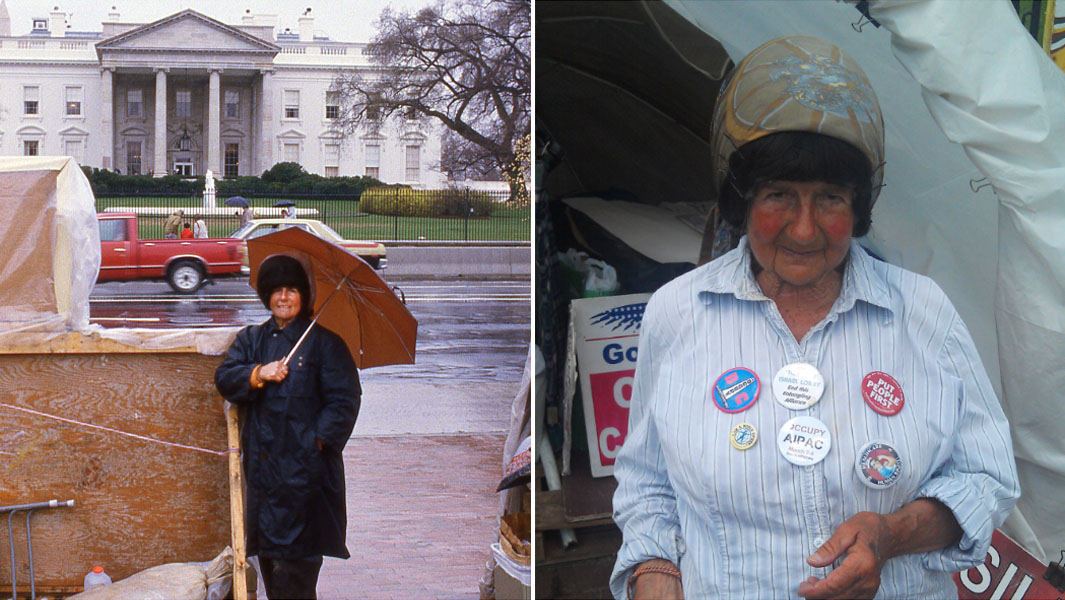Peace activist’s anti-nuclear protest outside White House lasted for record 34 years

For over three decades, Concepción "Connie" Picciotto camped in Lafayette Square opposite the White House in Washington, D.C., protesting the proliferation of nuclear weapons.
Connie, who moved from Spain to the USA in 1960, maintained the longest peace vigil by an individual in history, spanning 34 years 177 days from 1 August 1981 until her death, aged 80, on 25 January 2016.
Although she holds the record, Connie did not start the White House Peace Vigil; she joined forces with American anti-nuclear protester William Thomas, who started the sit-in on 3 June 1981 and remained for 27 years 234 days until he passed away on 23 January 2009.
Their camp was originally set up adjacent to the White House fence, but it was moved to the opposite side of the street as it violated local laws.

When Connie first joined the vigil, President Ronald Reagan was in the first year of his presidency.
Connie was a former embassy secretary in New York who had come to Washington seeking help from officials to resolve a dispute with her husband, whom she believed had organized an illegal adoption and was conspiring to have her committed to a psychiatric hospital.
Thomas, known to everyone by his last name, was a high-school dropout who’d held various jobs in New York and New Jersey, then embarked on an international pilgrimage before eventually ending up in Washington.
After coming across Thomas there, Connie sat down alongside him, and within hours, they were arrested for illegal camping. Upon their release, the pair decided to team up in their quest for world peace.
They devoted their lives to their cause, handing out pamphlets and displaying pro-peace, anti-nuclear proliferation signs outside America’s most iconic building.
As tents were banned in the park, Connie and Thomas operated out of a makeshift shelter constructed from a patio umbrella draped in a plastic sheet.
Day or night, rain or shine, Connie and Thomas were always there, spreading their message to anyone who would listen.
They survived on donations from passersby, charities, and local businesses such as a Hardee’s which would give them leftover food. They stealthily slept at the park, and when possible, they bathed at their friends’ homes.
Volunteers also took their place at times, allowing them to take short breaks from the vigil. On one such occasion, in 2013, a volunteer left the site overnight and the encampment was removed by local authorities, however, Connie and her supporters were able to redeploy the vigil in a matter of hours.

In 1984, Connie and Thomas were joined by Ellen Benjamin, who quit her job and married Thomas within six weeks of meeting him.
Connie was against the relationship and was hostile towards Ellen, but the protesters continued as a trio, nonetheless.
Over the following years, they endured confrontations with police, arrests, courtroom hearings, and jail stays. On one occasion, Thomas and Ellen were sentenced to 90 days for violating National Park Service rules, so Connie continued the vigil alone during this time.
The activists saw their biggest success in 1993, when they circulated a petition calling for nuclear disarmament, which resulted in a ballot initiative being passed.
Eleanor Holmes Norton, D.C.’s congressional delegate at the time, worked with the activists to write a nuclear disarmament and conversion act, but legislation has never reached Congress for a vote.
Despite this, Norton says that the activists’ work has not been fruitless. “Everybody who protests in this country understands how incremental change is, and if you’re not going to stick to it, it’s not going to happen,” she told The Washington Post.
“Maybe you can’t keep a movement going, but you can keep an issue alive.”
Connie passed away in 2016 at a housing facility operated by N Street Village, a nonprofit that supports homeless women in Washington.
Although she’s no longer alive, the White House Peace Vigil is still going strong. It marked its 40th anniversary in 2021, and its message is just as pertinent today as it was when it began.
“This vigil has grown to include the causes of peace because you can’t get rid of nuclear weapons easily unless we get rid of war,” said Michael Beer, a longtime supporter of the vigil.
“We can’t get rid of war unless we talk about human rights and so this vigil has taken on human rights around the world.”
If you love watching records being broken you should check out our Records Weekly series on YouTube...
Want more? Follow us on Google News and across our social media channels to stay up-to-date with all things Guinness World Records! You can find us on Facebook, Twitter/X, Instagram, Threads, TikTok, LinkedIn, and Snapchat Discover.
Don't forget to check out our videos on YouTube and become part of our group chat by following the Guinness World Records WhatsApp channel.
Still not had enough? Click here to buy our latest book, filled to the brim with stories about our amazing record breakers.


